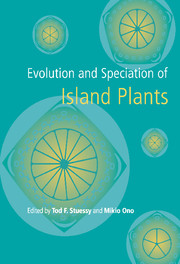Book contents
- Frontmatter
- Contents
- List of contributors
- Preface
- Acknowledgements
- Part one Hawaiian Islands
- Part two Juan Fernandez Islands
- Part three Southern and western Pacific Islands
- Introduction
- 6 Genetic diversity of the endemic plants of Bonin (Ogasawara) Islands
- 7 Evolution of cryptic dioecy in Callicarpa (Verbenaceae) on the Bonin Islands
- 8 Conservation of the endemic vascular plant species of the Bonin (Ogasawara) Islands
- 9 Preliminary observations on the evolution of endemic angiosperms of Ullung Island, Korea
- 10 Evolution in Crossostylis (Rhizophoraceae) on the South Pacific Islands
- Part four General evolutionary patterns and processes on oceanic islands
- Author index
- Taxon index
- Subject index
7 - Evolution of cryptic dioecy in Callicarpa (Verbenaceae) on the Bonin Islands
Published online by Cambridge University Press: 04 May 2010
- Frontmatter
- Contents
- List of contributors
- Preface
- Acknowledgements
- Part one Hawaiian Islands
- Part two Juan Fernandez Islands
- Part three Southern and western Pacific Islands
- Introduction
- 6 Genetic diversity of the endemic plants of Bonin (Ogasawara) Islands
- 7 Evolution of cryptic dioecy in Callicarpa (Verbenaceae) on the Bonin Islands
- 8 Conservation of the endemic vascular plant species of the Bonin (Ogasawara) Islands
- 9 Preliminary observations on the evolution of endemic angiosperms of Ullung Island, Korea
- 10 Evolution in Crossostylis (Rhizophoraceae) on the South Pacific Islands
- Part four General evolutionary patterns and processes on oceanic islands
- Author index
- Taxon index
- Subject index
Summary
Abstract
Examination of flower morphology and function of three species of genus Callicarpa (Verbenaceae) endemic to the Bonin Islands, C. glabra, C. nishimurae and C. subpubescens, reveals all three species to be dioecious. Male plants have short-styled flowers with sterile ovaries, whereas female plants have long-styled flowers with non-germinating pollen grains. Although the non-germinating pollen grains of female flowers are inaperturate, their size and content are almost the same as the normal 3-colpate pollen grains of male flowers. On the Bonin Islands, the insect fauna for the pollination of Callicarpa plants is sparse and the flowers of the three species produce little nectar. The non-germinating pollen grains of the female flowers may have been maintained as a reward for insect pollinators. Such an unusual dioecism has never been reported from Verbenaceae. The sexual system of Callicarpa on the Bonin Islands might have evolved under biological conditions unique to small oceanic islands.
The evolution of dioecy in flowering plants has been discussed as one of the interesting phenomena in evolutionary biology (e.g., Darwin, 1877; Lewis, 1942; Ross & Weir, 1976; Charlesworth & Charlesworth, 1978; Bawa, 1980; Ross, 1980; Lloyd, 1980; Charnov, 1982; Willson, 1983). Furthermore, the existence of dioecy in island plants has received considerable attention by several workers (Baker, 1955, 1967; Carlquist, 1974; Bawa & Opler, 1975; Ehrendorfer, 1979; Bawa, 1980, 1982; Baker & Cox, 1984; Cox, 1985).
Concerning the colonization of dioecious plants on islands, Bawa (1980, 1982) examined various ecological attributes of dioecy and suggested that dioecious taxa may have been disproportionately more successful in colonizing islands than hermaphroditic taxa.
- Type
- Chapter
- Information
- Evolution and Speciation of Island Plants , pp. 155 - 168Publisher: Cambridge University PressPrint publication year: 1998
- 5
- Cited by



